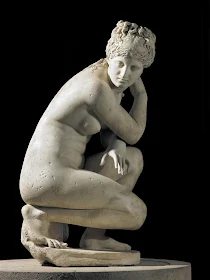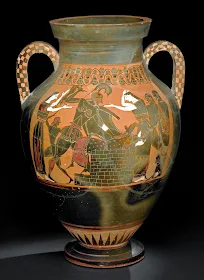Μαρμάρινο άγαλμα
γυμνής Αφροδίτης. Ρωμαϊκό αντίγραφο, 2ος αι. μ.Χ. Royal Collection Trust/Her
Majesty Queen Elizabeth II, 2015.
Την
εξέλιξη των κανόνων του ωραίου στην αρχαία Ελλάδα και τις επιρροές τους
παρουσιάζει το Βρετανικό Μουσείο σε έκθεσή του, συγκεντρώνοντας εμβληματικά
αγάλματα που περιλαμβάνονται στη συλλογή του καθώς και «θαυμαστά» δάνεια από
άλλα μουσεία.
Ρωμαϊκό
αντίγραφο του περίφημου Δισκοβόλου του Μύρωνα, από τη συλλογή του Βρετανικού
Μουσείου. Nobility of nudity: a Roman copy of Myron’s 5th
century BC bronze discus-thrower (discobolus).
Με
τίτλο «Ο ορισμός του ωραίου: το σώμα στην
τέχνη στην αρχαία Ελλάδα», η έκθεση παρουσιάζει τις διάφορες απεικονίσεις
του σώματος στην αρχαία Ελλάδα.
Figure of a River
God, (circa 438-432BC) – one of the Parthenon Sculptures or ‘Elgin Marbles’. It
comes from the west pediment of the Parthenon, and is thought to represent the
river Ilissos. To get a figure to fit the
space of a pediment’s raking cornice, you have to make it miniature or have it
recline, and once you’ve got the figure to lie, it becomes a good subject for
representing water, as it “flows” into the corner. The piece has about it that
shifting indefinable quality of breathing vitality; cold marble is made lissom
and languid by a process of almost magical alchemy and turned into warm flesh
and flowing drapery, which is then converted again into water.
Το
ιδεατό και παγκόσμιο του καιρού των μεγάλων γλυπτών της Αθήνας κατά τον 5ο
αιώνα π.Χ. γίνεται πιο προσωπικό και ρεαλιστικό την εποχή του Μεγάλου
Αλεξάνδρου, στο τέλος του 4ου αιώνα π.Χ.
Marble metope from
the Parthenon, by Pheidias. Photograph: PR
A Marble relief
(Block XLVII) from the North frieze of the Parthenon.
A figure of a naked
man, possibly Dionysos. Designed by Phidias, Athens, Greece, 438BC-432BC.
Στην
έκθεση περιλαμβάνονται και έξι από τα περίφημα Γλυπτά του Παρθενώνα, καθώς και
«θαυμαστά» δάνεια, σύμφωνα με την έκφραση του διευθυντή του Βρετανικού
Μουσείου, Νιλ ΜακΓκρέγκορ. Μεταξύ των δανείων αυτών είναι ένα εκπληκτικό
μπρούτζινο άγαλμα το οποίο ανασύρθηκε από τα νερά της Μεσογείου το 1999 και
πλέον ανήκει στην Κροατία.
Bronze statuette of
Zeus (1st-2nd century AD). This representation of the great Lord Olympus, some
20cm high, is an extraordinary piece: macho, commanding, erotically inspiring,
all the things that the male body can be. It came into the British Museum
collection in the mid 19th century having been in the collection of Dominique
Vivant Denon, the first director of the Louvre.
‘Lely’s Venus’ a
Roman copy of the lost Greek original (Royal Collection Trust/Her Majesty Queen
Elizabeth II 2015). She’s a truly exceptional piece of carving and composition
who represents the danger of getting too close to goddesses: the idea is that
you approach her from behind and you see her broad flat back, her head looking
forcefully down over her right shoulder, and her right arm reaching over her
left shoulder and seeming to play with our attention and beckon us to move
closer. So we do first a quarter turn, and then a three-quarter turn, but
finally our expectations are denied because we do not get an intimate view of
her sexual parts and instead what we get is an intimidating stare. A piece that
seems at first welcoming is in fact, very threatening.
The Belvedere Torso
(1st century BC to 1st century AD). This piece was much praised by
Michelangelo, and inspired The Creation of Adam; when asked by the Pope to
restore it, he refused on the grounds it was an inimitable work of art which,
though broken, possessed the ideal principles of Greek sculpture. I think it’s
probably a representation of Hercules, after his labours, awaiting divinity,
though there are a few different theories – there is a suggestion that he’s
Ajax – and what’s so remarkable about it is the articulation of the different
planes of the body; it’s like a cubist painting by Picasso.
«Πρόκειται
για μία από τις μεγαλύτερες αρχαιολογικές ανακαλύψεις των τελευταίων 30 ετών»,
εξήγησε ο ΜακΓκρέγκορ.
Statuette of a
veiled and masked dancer, aka the Baker Dancer (3rd-2nd century BC). It’s a
virtuoso, almost dazzling display of modelling, first of all in clay and then
cast in bronze, of a female dancer using her drapery to suggest the body
beneath, which she’s clearly very proud of. It’s a great example of the use of
drapery as sexual innuendo by sculptors in a society where the depiction of the
female body was more problematic than the male.
Marble statue of a
boy athlete, aka the Westmacott Athlete (1st century AD). This is a copy of a
lost Greek original from around the time of Socrates, and I like to think of
him as from Plato’s Charmides, a dialogue in which a beautiful boy is admired
and interrogated by Socrates, who determines that he is not only beautiful but
morally sound: he is drawn even more to him because he demonstrates “charis” or
grace. You can also see here how the sexuality of the athletic nude is reduced
by the downsizing of the genitals – and there’s no thrusting as you find with
the goal-scoring footballers of today.
«Είναι
ένας εθνικός θησαυρός και μια ευκαιρία για εμάς να δούμε πώς έμοιαζαν
πραγματικά τα ελληνικά, μπρούτζινα αγάλματα», πρόσθεσε.
LMUs Doryphoros:
Georg Römer reproduced what were regarded as the qualitatively most convincing
and best preserved elements of three Roman copies. (Snapshot of the
exhibition’s trailer)
Πραγματικά,
πολλά από τα μπρούτζινα αγάλματα έχουν εξαφανιστεί, καθώς καταστράφηκαν κατά
την αρχαιότητα επειδή είχαν μεγαλύτερη αξία ως μέταλλο παρά ως έργα τέχνης. Η
πλειονότητά τους έχει φτάσει ως την εποχή μας μέσω μαρμάρινων, ρωμαϊκών
αντιγράφων.
Black-figured
amphora featuring the death of Priam, 550BC-540BC. Photograph: PR
Η
έκθεση αυτή, η πρώτη μιας σειράς που έχει στόχο να επιδείξει τις μόνιμες
συλλογές του Βρετανικού Μουσείου, θα διαρκέσει ως τις 5 Ιουλίου 2015.
Defining Beauty is at the British Museum, London WC1, from March 26 to
5 July, sponsored by Julius Baer. Details: britishmuseum.org.














Απίστευτη τεχνική αρτιότητα,κατόρθωσαν να εμφυσήσουν στον μπρούτζο και στο μάρμαρο ψυχή!!!
ΑπάντησηΔιαγραφή